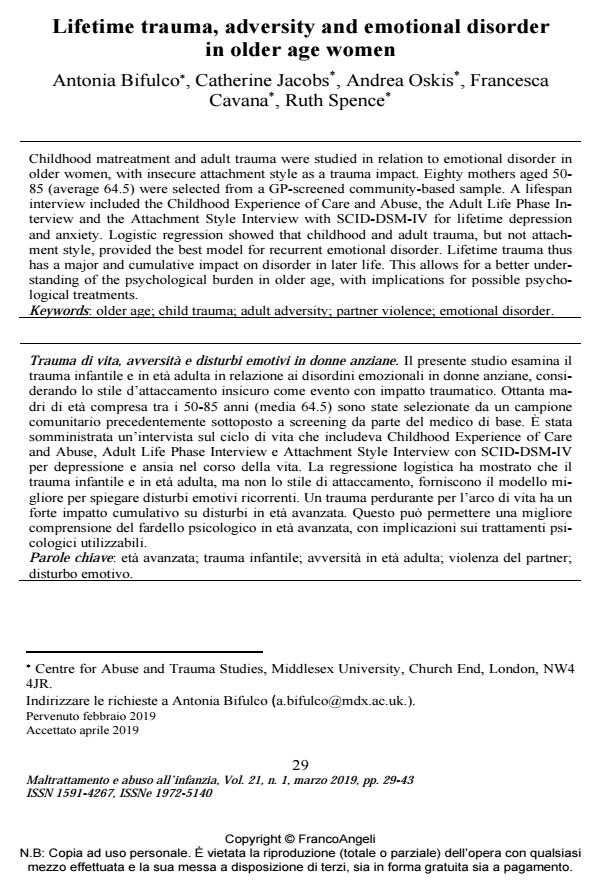Lifetime trauma, adversity and emotional disorder in older age women
Titolo Rivista MALTRATTAMENTO E ABUSO ALL’INFANZIA
Autori/Curatori Antonia Bifulco, Catherine Jacobs, Andrea Oskis, Francesca Cavana , Ruth Spence
Anno di pubblicazione 2019 Fascicolo 2019/2
Lingua Inglese Numero pagine 15 P. 29-43 Dimensione file 213 KB
DOI 10.3280/MAL2019-002003
Il DOI è il codice a barre della proprietà intellettuale: per saperne di più
clicca qui
Qui sotto puoi vedere in anteprima la prima pagina di questo articolo.
Se questo articolo ti interessa, lo puoi acquistare (e scaricare in formato pdf) seguendo le facili indicazioni per acquistare il download credit. Acquista Download Credits per scaricare questo Articolo in formato PDF

FrancoAngeli è membro della Publishers International Linking Association, Inc (PILA)associazione indipendente e non profit per facilitare (attraverso i servizi tecnologici implementati da CrossRef.org) l’accesso degli studiosi ai contenuti digitali nelle pubblicazioni professionali e scientifiche
Childhood matreatment and adult trauma were studied in relation to emotional disorder in older women, with insecure attachment style as a trauma impact. Eighty mothers aged 50-85 (average 64.5) were selected from a GP-screened community-based sample. A lifespan interview included the Childhood Experience of Care and Abuse, the Adult Life Phase Interview and the Attachment Style Interview with SCID-DSM-IV for lifetime depression and anxiety. Logistic regression showed that childhood and adult trauma, but not attachment style, provided the best model for recurrent emotional disorder. Lifetime trauma thus has a major and cumulative impact on disorder in later life. This allows for a better understanding of the psychological burden in older age, with implications for possible psychological treatments.
Il presente studio esamina il trauma infantile e in età adulta in relazione ai disordini emozionali in donne anziane, considerando lo stile d’attaccamento insicuro come evento con impatto traumatico. Ottanta madri di età compresa tra i 50-85 anni (media 64.5) sono state selezionate da un campione comunitario precedentemente sottoposto a screening da parte del medico di base. È stata somministrata un’intervista sul ciclo di vita che includeva Childhood Experience of Care and Abuse, Adult Life Phase Interview e Attachment Style Interview con SCID-DSM-IV per depressione e ansia nel corso della vita. La regressione logistica ha mostrato che il trauma infantile e in età adulta, ma non lo stile di attaccamento, forniscono il modello migliore per spiegare disturbi emotivi ricorrenti. Un trauma perdurante per l’arco di vita ha un forte impatto cumulativo su disturbi in età avanzata. Questo può permettere una migliore comprensione del fardello psicologico in età avanzata, con implicazioni sui trattamenti psicologici utilizzabili.
Parole chiave:Età avanzata; trauma infantile; avversità in età adulta; violenza del partner; disturbo emotivo
- Historical child abuse and intergenerational transmission: Experiences of midlife women and their older-age mothers Antonia Bifulco, Catherine Jacobs, Elena Carraro, in MALTRATTAMENTO E ABUSO ALL'INFANZIA 3/2019 pp.23
DOI: 10.3280/MAL2019-003003 - Assessing physiological autonomic reactivity and appraisal in psychogenic pseudosyncope: Preliminary evidence from a pilot study with two single-cases Davide Crivelli, Michela Balconi, in MALTRATTAMENTO E ABUSO ALL'INFANZIA 1/2020 pp.55
DOI: 10.3280/MAL2020-001005 - Trauma and syncope: Which relationship do they share? Davide Crivelli, Michela Balconi, in MALTRATTAMENTO E ABUSO ALL'INFANZIA 1/2020 pp.35
DOI: 10.3280/MAL2020-001004 - Abuse, emotion regulation, and interoception: What can studies on the brain-body interaction tell us? Laura Angioletti, Michela Balconi, in MALTRATTAMENTO E ABUSO ALL'INFANZIA 1/2020 pp.9
DOI: 10.3280/MAL2020-001002
Antonia Bifulco, Catherine Jacobs, Andrea Oskis, Francesca Cavana , Ruth Spence, Lifetime trauma, adversity and emotional disorder in older age women in "MALTRATTAMENTO E ABUSO ALL’INFANZIA" 2/2019, pp 29-43, DOI: 10.3280/MAL2019-002003